To mark the arrival of Heritage Open Days, England’s largest festival of history and culture, we are delving deeper into the life and work of German painter and sculptor Hans Feibusch – 125 years on from his birth.
This article has contributions from the Cathedral’s Canon Precentor, the Reverend Dr Daniel Inman, and Pallant House Gallery, which present day is the home of the contents of Feibusch’s North London studio following his death in 1998.
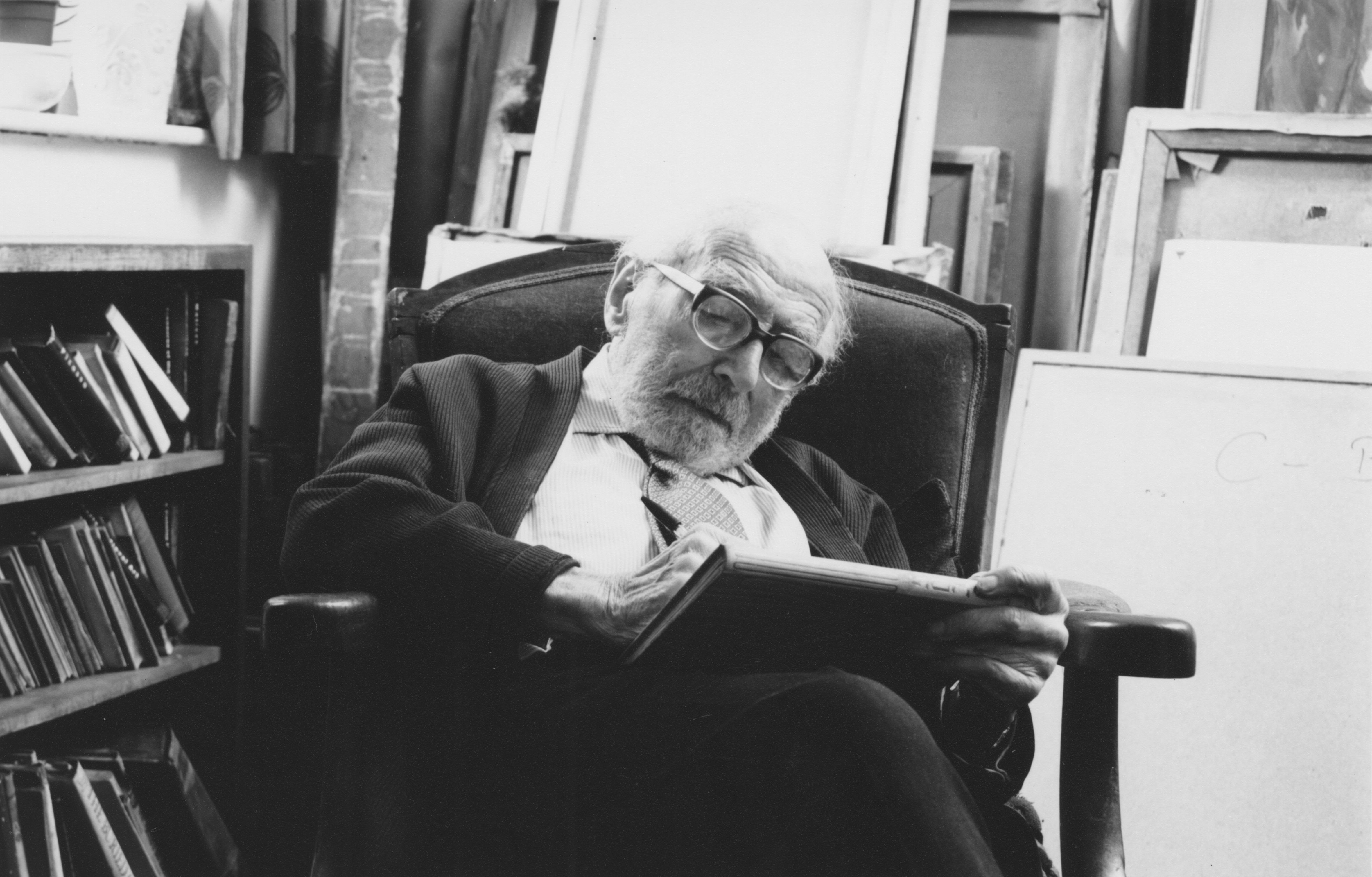
Exiled from Germany in 1933 (his work reviled and then banned by the Nazis and later included in the notorious Degenerate Art exhibition of 1937), Hans Feibusch (1898 – 1998) made a major artistic contribution to the reconstruction of post-war Britain through his extraordinary series of mural paintings.
© Pallant House Gallery
Originally from Frankfurt am Main, Feibusch was born to Jewish parents and served in the German Army on the Russian front during the First World War. After the war, he studied art in Munich working under the expressionist painter Karl Hofer and cubist Andre Lhote in Paris. During the 1920s he travelled across Italy, where he admired the work of Renaissance masters such as Masaccio, Piero della Francesca and Benozzo Gozzoli whose influence can be seen in his later work.
Forced to flee Nazi Germany, he found refuge in Britain in 1933, and in 1934 first exhibited with the Ben Uri Gallery in May - June, showing concurrently in the Exhibition of German-Jewish Artists' Work at the Parsons Gallery, London, organised by German-Jewish émigré dealer Carl Braunschweig (Charles Brunswick) to highlight artists suffering persecution under the Nazi regime. Later that year, Feibusch held the first of five solo shows at the Lefevre Galleries, London, and also began to exhibit regularly with the London Group. In 1938 his work featured in the important exhibition of ‘Twentieth-century German Art’ at the New Burlington Galleries in London, intended as a riposte to the Nazi Degenerate Art exhibition of the previous year.
His first commission, The Footwashing for the Methodist Chapel, Colliers Wood, London (1938), came to the attention of George Bell, then Bishop of Chichester. A patron of the arts and passionate about bringing the church and contemporary artists together, Bell became an important figure in Feibusch’s professional life commissioning several major murals including those in Chichester Cathedral and St. Elizabeth’s, Eastbourne.
Feibusch went on to become Britain’s most prolific muralist, creating work in some 35 Anglican churches and cathedrals, among them St. John's Waterloo, Saint Michael and All Angels, Paulsgrove, Portsmouth and Saint Mary’s, Goring-by-Sea in Sussex in addition to secular murals at Newport Civic Centre and Dudley Town Hall. Often assisted by British artist and illustrator Phyllis Bray, his work is typified by a bold use of colour and distinctive approach to the relationship between painting and architecture. In 1946 he published his book Mural Painting and featured in the 1951 Festival of Britain as both a painter and a muralist.
In later years he turned to sculpture, exploring themes of mythology and religion as well as portrait busts. Commissions during the 1970`s included a seven foot figure of St. John the Baptist at St. John’s Wood Church and sculptures of Christ at Ely Cathedral and St. Albans the Martyr, Holborn in 1985.
Feibusch continued to work until his death a few weeks before his 100th birthday in July 1998.
Chichester Cathedral: A Masterpiece of Sacred Art
Feibusch was drawn into the life of Chichester Cathedral through the influence of Bishop George Bell, who had read Feibusch's 1947 book. Here Feibusch had urged the church authorities to draw upon the skills of an emerging set of young British artists for ecclesiastical decoration and the friendship between the two men led to a set of commissions both in the Cathedral Close and across the Diocese of Chichester.
The two most important works are the Baptism of Christ (painted in 1951, when the artist was 53) and the Ascension in the Bishop's Chapel (part of the Palace complex), painted in 1953.
.jpg)
© Chichester Cathedral (Hans Feibusch's Baptism of Christ, 1953)
Initially, the Baptism had covered what had become the rather unsightly door of the south-west tower of the Cathedral, opposite the font. Bell had received a gift of £200 that he wanted to devote to mural painting in the Cathedral (at a time when restrictions on such undertakings were very light) and the Baptistry seemed like an obvious choice. It lacked ornamentation and Bell thought a mural might effectively cover the door of the south-west tower of the Cathedral, which had gone out of use. The Chapter was initially hesitant, writing to Bishop Bell after their June meeting in 1951 that it was 'resolved that the Dean should write to the Bishop explaining that if the mural had been offered by anyone else but his lordship, the Chapter would have felt bound to decline it, as they were not convinced that it was a great work of art.' (Dean and Chapter Minutes, 29 Sept 1950)
Feibusch wrote of it that he desired something 'relief-like', and a 'strongly modelled panel, with large forms, easily readable and strong in colour in the dim light...The colour is based on the grey-green of the Cathedral stone, which helps to relate to my painting to the surroundings; contours and deep shadows are black or mahogany, and there are some patches of yellow and orange, in the background, of bright blue.' His desire, he wrote, was to 'help the worshipper, to lead his thoughts from the tumultuous outer world towards an inner spiritual one, and to serve as a point of departure for his meditations.' (Feibusch, H., 'Mural Paintings in Churches' in The Studio, April 1954, 105-06).
.jpg)
© Chichester Cathedral (Hans Feibusch's Baptism of Christ, 1953)
Feibusch's inspiration was almost certainly Piero della Francesca's Baptism of Christ in the National Gallery, Feibusch reproducing Piero's positioning of Christ's hands, bringing into sharp relief against the Caen stone this definitive moment in Christ's life in which the Second Person of the Trinity identifies, in solidarity, with our humanity; and in which he is declared by the hidden voice of the Father to be 'my beloved Son' to whom we must listen, his anointing witnessed in the descent of the Holy Spirit in the form of a dove.
When the mural was moved to the western wall after the south-west door was reopened in 1977, the ethereal quality communicated in Feibusch's colours and bold figuration were given greater clarity, not least since the mural was removed from the shadows of the doorway.
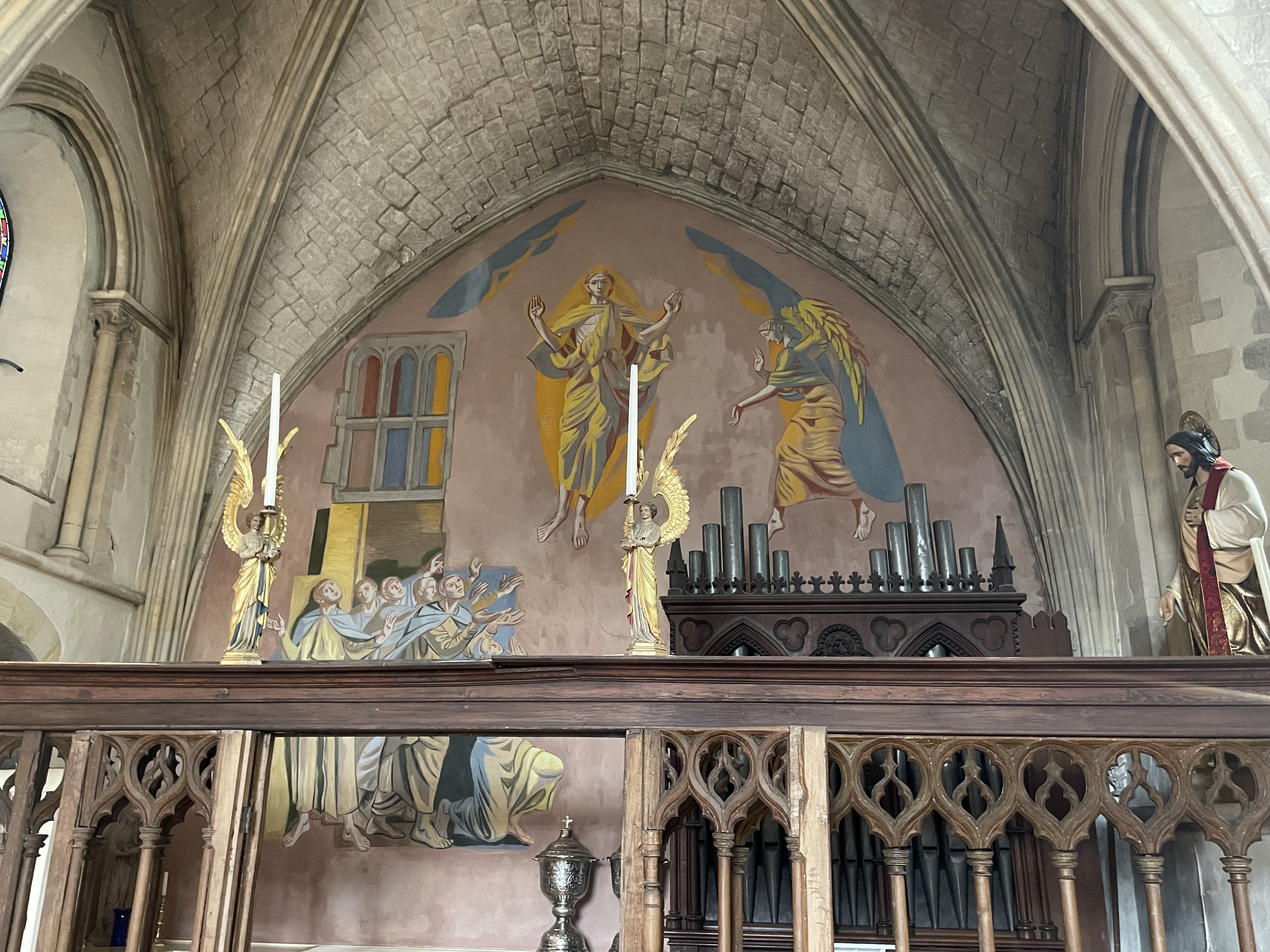
© Chichester Cathedral (Hans Feibusch's Ascension, 1953)
The Ascension in the Bishop's thirteenth-century private chapel, similarly, sought to evoke the drama of the Gospel story of Christ's ascension into Heaven. Here, without the scrutiny of the Cathedral Chapter, Bell could be freer with the commission and Feibusch painted, within the physical context and structure of the west end of the Chapel, a vision of Christ's ascending into glory within the intimacy of this domestic setting. Blocked-up mullions at the west end of the chapel are employed to give definition to a painted doorway beneath, from which the disciples emerge to look in wonder at their Lord ascending, an angel to his right paying homage (above the chapel's organ). The dynamic blues and yellows of Christ contrast with the terracotta background to create something of an evangelistic stage-set within the Chapel.
Pallant House Gallery: Sustaining Artistic Legacy
In 1997 Pallant House Gallery received the entire contents of Hans Feibusch’s North London studio. The studio (formerly that of Sir Edwin Landseer) was used by Feibusch for almost 60 years, from his arrival in Britain until
1997. The Hans Feibusch collection includes around 80 paintings, 50 sculptures, several hundred drawings and studies, copies of all Feibusch’s lithographs (around 50 prints including proof stages), as well as the artist’s sketch books, easels, brushes, props, furniture and books – over 1,700 items in total. The Gallery also houses the Hans Feibusch Archive of photographs and ephemera, which is available to view by appointment in our Library and Reading Room.
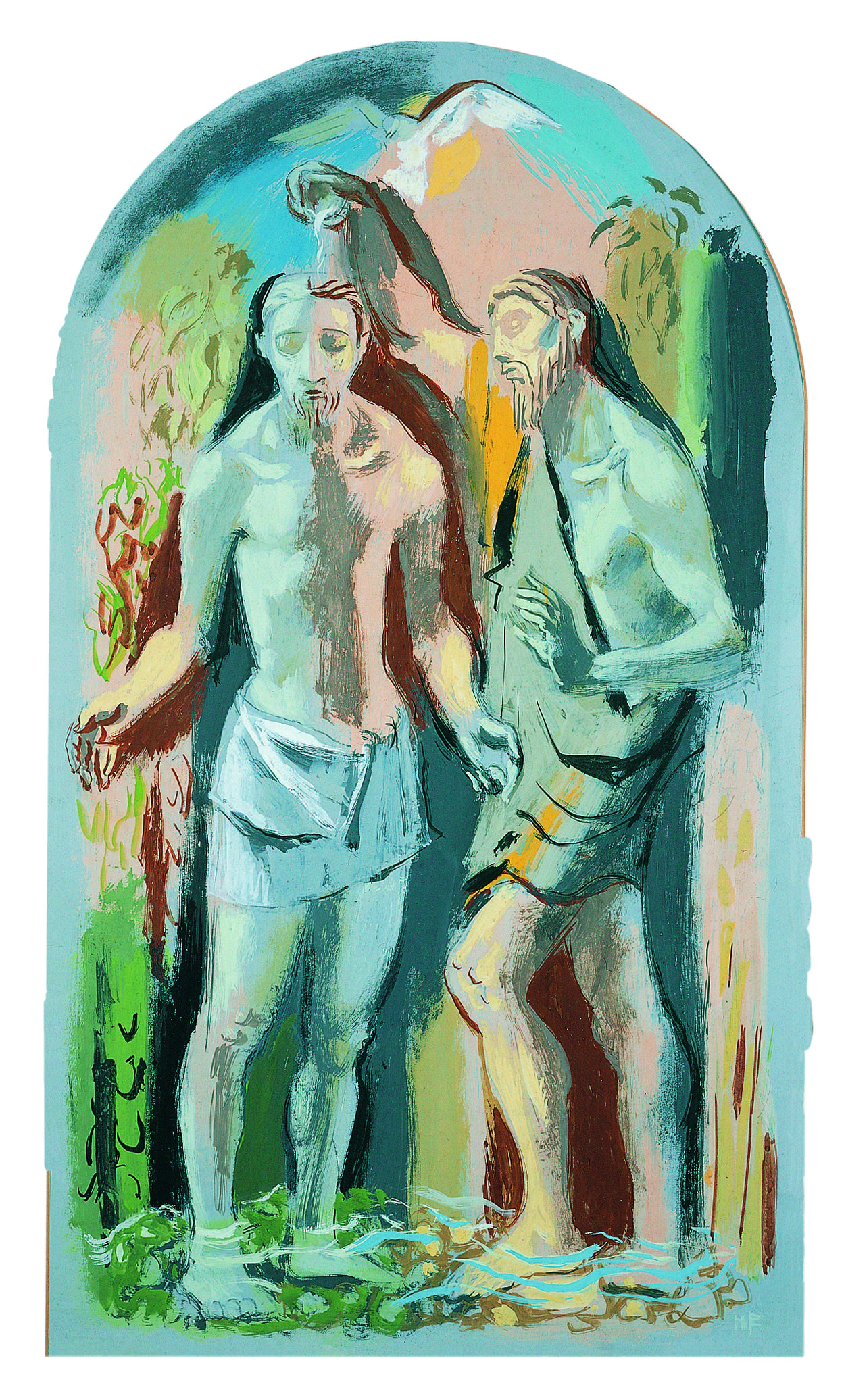
© Pallant House Gallery (Hans Feibusch's preparatory studies for The Baptism of Christ, 1951)
The art collection includes preparatory studies for The Baptism of Christ (1951) in Chichester Cathedral and the Gallery has, since 2004 loaned to the Cathedral the oil painting Resurrection (1969) which hangs in the Cathedral Treasury in addition to a selection of works at George Bell House.
The collection gives opportunity to explore Feibusch’s extraordinary output, draughtsmanship and extensive interests not limited to large scale murals, but including designs for the stage and domestic interiors, drapery studies, decorative friezes, classical architecture and landscape. He takes his place within the rich and influential legacy of émigré artists such as Josef Herman, Jankel Adler, Oskar Kokoschka and Siegfried Charoux all represented within the Pallant House Gallery collection together with those artists who arrived in Britain as child refugees in the late 1930s, most famously Frank Auerbach and Lucian Freud.
Feibusch retained a particular figurative style influenced by the Renaissance and his influence lay primarily in his mural painting, and his place within the history of church patronage. His haunting work Narcissus (1946) currently on show in the permanent collection display, presents an example of his bold use of colour and strong modelling of the figure and is also typical of the introspection of much art of the post-war period.
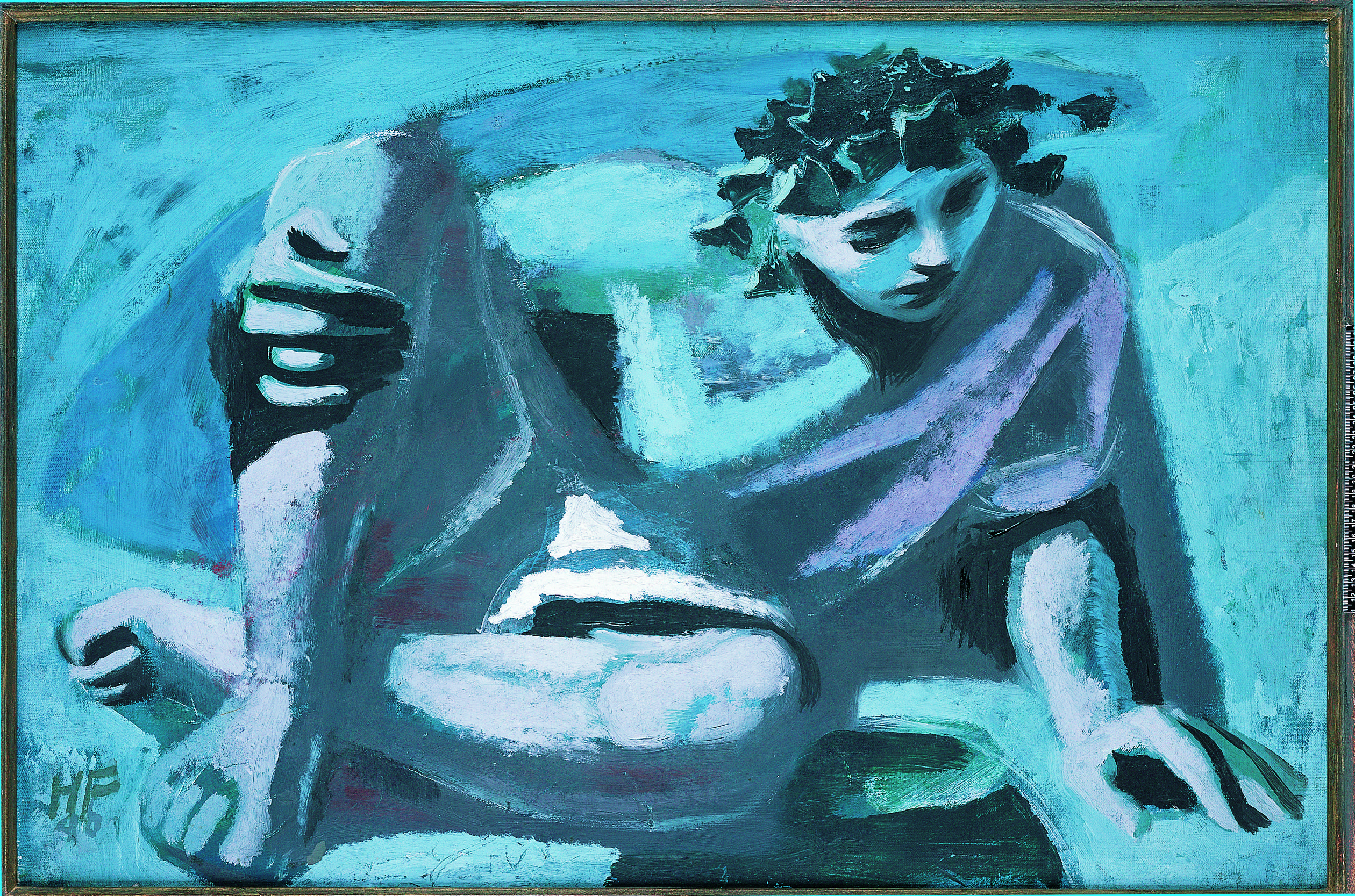
© Pallant House Gallery (Hans Feibusch's Narcissus, 1946)
Feibusch's work, in the Cathedral Quarter, and across the Diocese acted as something of a 'morning star' to an era at Chichester in which the sacred and the artistic would find a new dynamism under Bell's appointment of Walter Hussey (1909-85) as Dean in 1955. A decade after Feibusch, Hussey would be employing Graham Sutherland and John Piper in his refurbishment of the St Mary Magdalen Chapel and High Altar respectively. In all of this, Feibusch's own commitment to the integration of contemporary artists with the art of worship had been crucial, not least in the mind of George Bell. That it was a Jewish refugee artist who should prompt this 'renaissance' of modern British art in English cathedrals is particularly striking.
It is fair to say that fewer contemporary artists of note are now able to engage with the biblical imagination with such confidence as Feibusch did in the mid-twentieth century, with most cathedrals increasingly inclined to stage temporary exhibitions of art with invariably little reference to Bible or the Christian tradition (and certainly with limited appetite to quote the Renaissance masters).
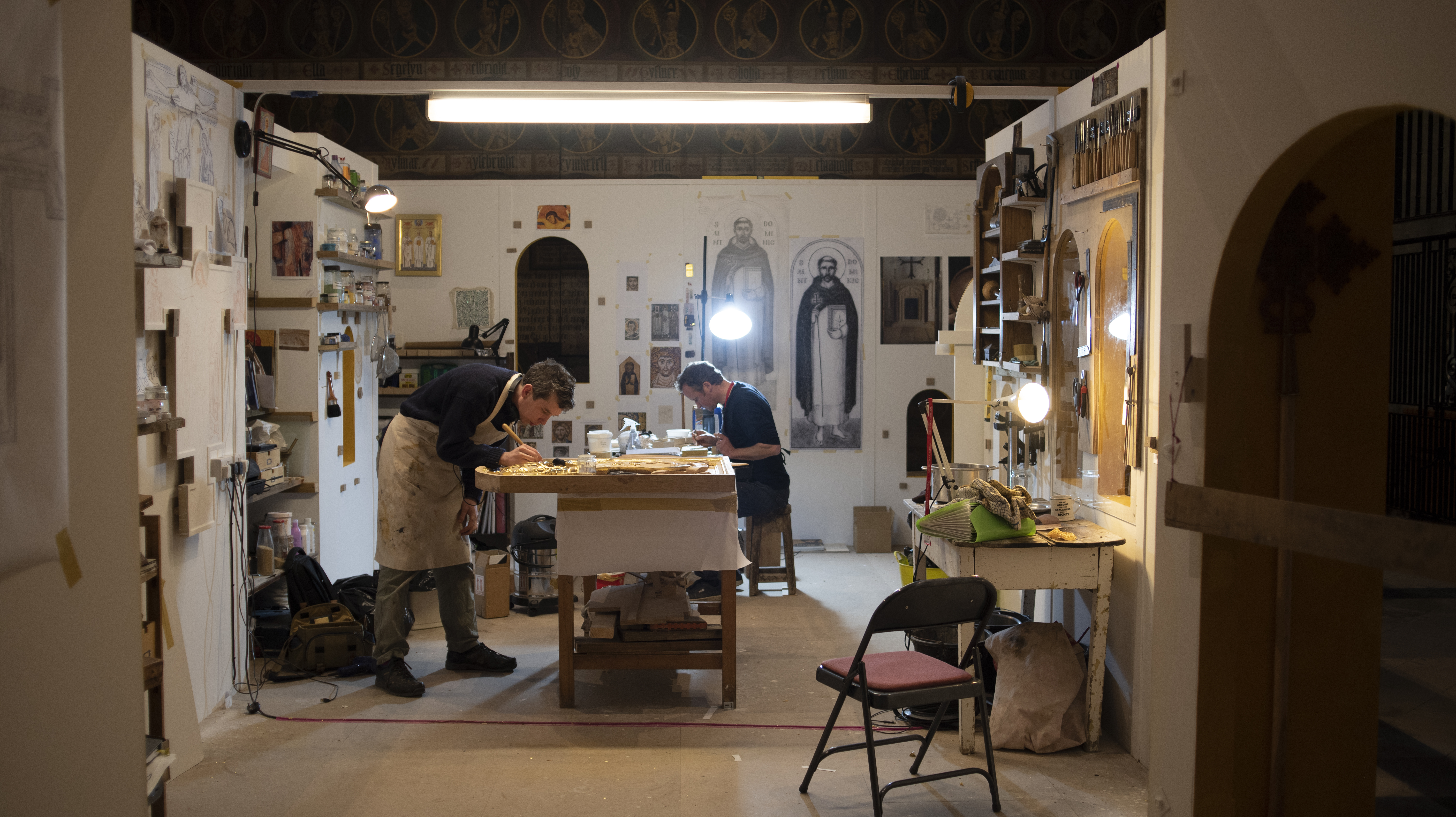
© Chichester Cathedral, 2021
Chichester itself, however, continues to seek the integration of art and worship, not least through its current work with practising liturgical artists Aidan Hart, Martin Earle and James Blackstone, and Chapter's desire to establish an international centre of liturgical art (its production and teaching) in the Cathedral Close by 2025.